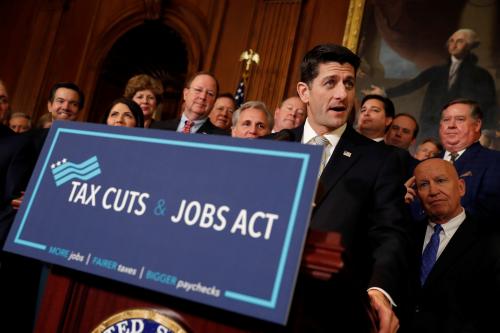Federal tax policy will take center stage next year, with Republican President-elect Donald Trump leading a unified government and many provisions of the Tax Cuts and Jobs Act (TCJA) expiring at the end of 2025. But five issues will shape the tax debate, leaving lawmakers with four possible scenarios.
1. The fiscal outlook is bleak.
Over the next 10 years, the Congressional Budget Office (CBO) projects federal debt—which currently stands at 99% of GDP—will rise to 122% of GDP, an all-time high. These 10-year figures will look worse if there is a recession, a war, or a tax cut. A sound fiscal path will require some combination of increases (not cuts) in taxes and reductions in spending growth.
2. Extending the temporary provisions of TCJA would be costly and regressive.
Estimates based on CBO projections indicate that extending the expiring provisions in TCJA would cost over $5 trillion over the next 10 years in terms of lost revenue and added interest payments. The extension would also be highly regressive. A Tax Policy Center analysis shows that the top 1% would get nearly a quarter of the benefits, while the bottom 20% would receive less than 2%. If reductions in entitlement spending finance these tax cuts, the vast majority of low-income households will be worse off than if neither the tax cut extension nor the spending cuts were enacted.
3. Trump’s other tax cut proposals are costly.
During the campaign, Trump embraced numerous additional tax cuts, including exemptions for income from tips, overtime work, and Social Security benefits, which together would cost an estimated $3.6 trillion over the next decade and would hasten the insolvency of the Social Security trust fund. He also proposed a full repeal of the cap on state and local tax deductions, which would cost another $1.2 trillion, plus tax breaks for car loan interest payments and military personnel, first responders, and Americans living abroad. He also proposed reducing the corporate income tax rate to 15%, which would cost at least $600 billion over the next decade. A tax cut for just domestic production would cost about half as much, but providing a targeted deduction would create room for gaming the system, as previous rules did in the past.
4. Tariffs create several problems.
In addition to a broad 10 to 20% tariff on all imports, Trump has proposed 60% tariffs on all Chinese goods. Tariffs are estimated to generate $2.8 trillion over 10 years, accounting for their impact on the U.S. economy. But revenue will be lower in the nearly inevitable case that other countries retaliate.
5. Senate rules will limit tax policy choices.
Republicans will have to use the budget “reconciliation” process to advance any bills that lack bipartisan support. Reconciliation imposes several restrictions. First, Republicans must enact a budget resolution, which determines how large a tax cut is possible. Second, a reconciliation bill cannot address Social Security and cannot increase deficits after 10 years. Therefore, any reconciliation tax bill (like the TCJA) must be temporary or be paired with a corresponding tax increase or a reduction in spending. These rules and some Republicans’ desire to limit deficit growth will create a search for so-called “pay-fors.”
Taken together, lawmakers could take tax policy in one of at least four directions:
Go big, permanently. Republicans might try to pass all the tax cut proposals on a permanent basis. This would cost approximately $10 trillion over the next decade (give or take a trillion). But that price might be too high, especially with required (and substantial) pay-fors after the tenth year.
Go big, temporarily. To keep the reported deficit increase low, Republicans could go for a wide range of tax cuts with expiration dates that can be extended later—exactly like the expiring provisions from TCJA. For example, a package that costs $10 trillion over 10 years would cost only about $2 trillion over two years. Coupled with $1 trillion of pay-fors, the package would have an official cost of just $1 trillion. This would be a bit of a budget gimmick, though, since the official budget score would not count the costs of extending those tax provisions.
Go small, permanently. Alternatively, they might enact some of the tax cuts, but on a longer-term basis. This would still require that the deficit not rise after the tenth year, so Republicans would have to include pay-fors.
Go for two tax cuts. Republicans might use reconciliation to enact the tax changes that lack Democratic support, after which policymakers could come together to pass a bipartisan bill with popular provisions like the Child Tax Credit.
No matter what path Republicans take, it will be a consequential year for tax policy. Buckle up.
-
Acknowledgements and disclosures
The Brookings Institution is financed through the support of a diverse array of foundations, corporations, governments, individuals, as well as an endowment. A list of donors can be found in our annual reports published online here. The findings, interpretations, and conclusions in this report are solely those of its author(s) and are not influenced by any donation.
The Brookings Institution is committed to quality, independence, and impact.
We are supported by a diverse array of funders. In line with our values and policies, each Brookings publication represents the sole views of its author(s).








Commentary
Framing the upcoming tax debate: 5 issues, 4 paths
November 25, 2024